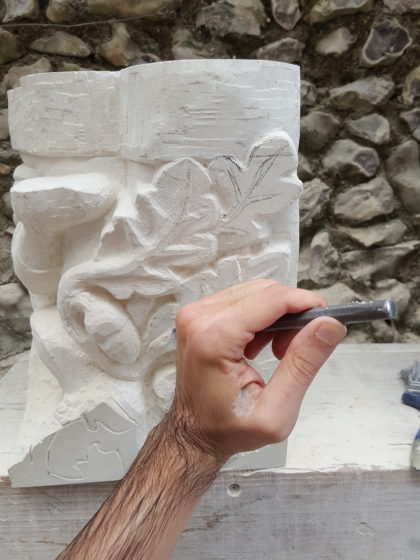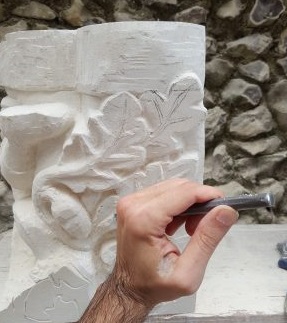Carvin’ology
 In the last couple of weeks I carved like never before, even up to 8 hours per day. It gave me a lot of time to think about sculpting in general. And here are some of those thoughts.
In the last couple of weeks I carved like never before, even up to 8 hours per day. It gave me a lot of time to think about sculpting in general. And here are some of those thoughts.
Inspiration: we probably smile when we hear the ancients romans or greeks saying that the Muses inspired them, but were they completely wrong? When I get my mind to focus on the stone it’s like being in a sort of trance. Time goes by without me knowing, hours and hours feel like minutes. My hands follow the first conscious command, like a trigger, but after that they do everything by themselves. Today we do know that “that inspiration” comes from the brain itself, from the way the brain connects and stores information but for the ancients it was simply a trascendent trance. A god that moves your hands, a god that inspires beauty. It is possible that when we are focused on something the internal clock in our brain is put on a side and does not interfere with the artistic process. The hands move by themselves because all the circuits are in the cerebellum and can move your body even without your consciousness being aware of it. Think about driving: we do drive without thinking. Same with this, chisel and mallet go by themselves. The thing is, we always talk about the brain but we should talk about the “brains”. What we call brain is actually a highly modular organ made of smaller sections that evolved at different moments in our evolutionary history. The cerebellum is one of the most ancient ones and the cortex, where our highest intellectual functions (consciousness) reside, is the newest. So when we carve we do actually go back in time to our most primitive functions.
It’s all about math: although primitive, our cerebellum is a supercomputer capable of measuring distances, speed, time, angles, etc. Think about how much precision it requires to simply start a blow of your chisel on the stone. First you need to coordinate your mallet hand with your chisel hand. Then the mallet needs to hit the back of the chisel in such a way that it can start the carving. Not too strong, not too weak, the strength actually changes depending on the surface, type of stone, type of cut that the artist wants to do, etc. The chisel hand adjusts the angle in X, Y and Z and the grip on the chisel itself. By changing grip you change type of cut as well. And all of this needs to be followed by your eyes that are giving feedback to visual cortex and directly to cerebellum. In turns from the cortex the brain is projecting its internal 3D model to all of these compartments. It is a continuous “try and check” until the shape of the stone mimics the one of the internal model.
It would be interesting to propose a fMRI study to a neuroscience department somewhere. Maybe we will find the Muse area of the brain.
Left-handed: it does not matter whether you are left-handed or right-handed, you will always hold your chisel with your less dominant hand. Which is very counterintuitive as the chisel hand is the one doing all the precision work. The mallet hand is simply the motor of the act of sculpting. It’s the chisel hand that does everything, changing direction, angle, grip etc. It is something that made me thinking quite a lot recently. How is that possible that we unconsciously choose to use the less dominant to do such a precision work? Maybe it’s not all about being dextrous (by the way, dextrous comes from the latin dexter, that means right) on the dominant hand but it’s also about having enough strength and precision to hit the chisel. Maybe the less dominant hand won’t be able to keep the pace and strength required.
